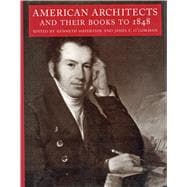As architects separated themselves from amateur and gentlemen designers on the one hand and masons and carpenters on the other, members of the profession were distinguished by their ability to draw and their possession of a common body of learning gleaned from printed sources. Clients and patrons expected architects to derive their designs from precedents communicated in books. These publications reproduced the work of European masters and, eventually, Anglo-American examples as well.
The essays in this volume range from studies of architectural publications available in the colonies, to the appearance of American architectural incunabula, to the revolution in architectural publishing that occurred in t









